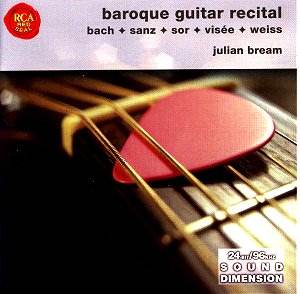The implication from reading the cover of this disk
is that this is a high resolution CD, when in fact it plays back in
16/44 sound like every other CD. The mastering from analogue sources
at higher resolution means that digital enhancement routines can be
applied to the resulting high resolution digital file; these will degrade
the sound to some degree, but the subsequent downsampling to 16/44 will
mask this degradation and result in a superior sounding recording than
if the enhancements had been applied to a lower resolution mastering.
When these recordings are compared to the original CD releases mastered
directly in 16/44 one can see that digital hum filtering and hiss reduction
have been applied. There is also greater dynamic range and clarity,
when compared to the original 16/44 CD releases. But this is not a DVD-Audio
disk.
These recordings were made at various times and places
and released on LP and then on CD as part of the "Julian Bream
Collection" on BMG/RCA. This enhanced sound anthology is a well
chosen sample of some of the better recordings from Julian Bream’s considerable
discography. This is probably the best sounding and most musically interesting
(6-string) guitar Baroque anthology disk you could buy. But if you already
own the original disks, be advised that these are the same recordings,
albeit sounding a little clearer.
The notes point out that a ‘Baroque’ guitar had 5 pairs
of strings rather than the six single strings of the modern guitar.
I have been unable to find a picture of Bream playing any type of guitar
other than the modern 6-string instrument, and I assume that is what
he is using for this disk. It is not surprising that some of the lute
works have had to be transposed to be played on the modern guitar since
the lute has a greater range than the guitar. The Bach tracks here are
probably the best 6-string guitar performances of these works. Lindberg’s
lute is a thinner sounding instrument and Lindberg is further from the
microphone than Bream, whereas Junghänel is more closely miked
and hence richer sounding. Paul Galbraith performing on an 8-string
guitar is generally superior in sound, concept and clarity of articulation.
Lindberg and Galbraith show the most imagination in improvising ornaments
on repeats. Junghänel plays skilfully but without much emotion.
Bream’s performance of the Sarabande of the e-minor suite is one of
his finest recordings, one of the finest guitar recordings ever made,
but Galbraith and Lindberg give him a close race. The lute disks and
the Bream disk have some high frequency finger-scrape noises, whereas
the Galbraith disks have none, and Galbraith’s sound is warmer in tone.
Either Galbraith is a more articulate performer, or some electronic
filtering has been applied to remove the noises.
The performances clearly show the genius of Weiss,
friend of Bach, probably the greatest lute virtuoso of all time, from
whom we have so little written music. The other works are all very interesting
and worthy of their companions on this disk.
Paul Shoemaker
